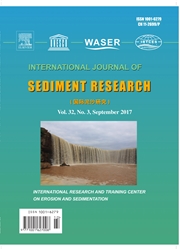

 中文摘要:
中文摘要:
由于在水动力学和严肃的效果之间的相互作用,河岸倒塌是在上面的黄河的荒芜的活动范围的普通出现(也作为Ningxia蒙古内部活动范围打电话),哪个河岸可以在宽山谷的荒芜的活动范围,河的平原上的淤泥免职河岸和淤泥沙的河岸被划分成象沙的河岸那样的三种类型。为折叠河岸的两典型河岸倒塌和粒子尺寸分布(PSD ) 的特征沙,淤泥免职,和淤泥沙的类型从从域观察获得的数据的分析被决定。从淤泥免职河岸的粒子从沙的河岸有最小的中部的尺寸和那些,这被发现最大,与那些,是中间的在里面缩放。PSD 沙并且分别地,当那些淤泥沙的河岸展出了多重山峰时,淤泥免职河岸展出了双 peaked 和达到顶点单人赛的结构。而且,相应于三种河岸倒塌机制被揭示。这些结果河动力学的理解与问候是重要的到并且到计划利用工程的河。
 英文摘要:
英文摘要:
As a result of the interaction between hydrodynamics and the effects of gravity, riverbank collapse is a common occurrence in the desert reach of the upper Yellow River (also called as Ningxia-Mongolia Inner reach), of which the riverbank may be divided into three types such as sandy riverbank in the widevalley desert reach, silt-deposition riverbank on the fluvial plain and silt-sandy riverbank. The characteristics of both typical riverbank collapse and the particle size distributions (PSDs) for collapsed riverbanks of sandy, silt-deposition, and silt-sandy types were determined from analysis of data obtained from the field observations. It was found that particles from the silt-deposition riverbank had the smallest median size and those from the sandy riverbank the largest, with those from the silt-sandy riverbank being intermediate in size. The PSDs of the sandy and silt-deposition riverbanks exhibited double-peaked and single-peaked structures, respectively, while those of the silt-sandy riverbank exhibited multiple peaks. Furthermore, the corresponding to three kinds of riverbank collapse mechanisms were revealed. These results are significant with regard both to the understanding of river dynamics and to the planning of river harnessing projects.
 同期刊论文项目
同期刊论文项目
 同项目期刊论文
同项目期刊论文
 期刊信息
期刊信息
